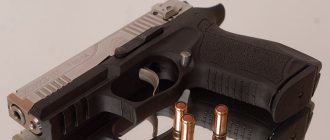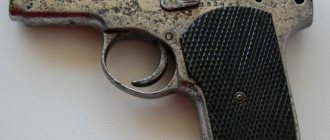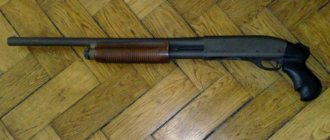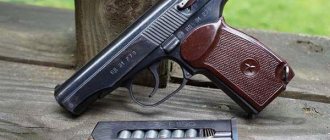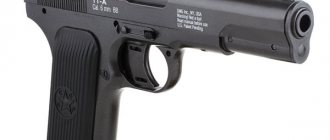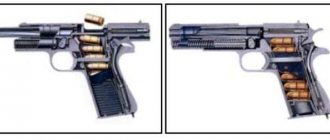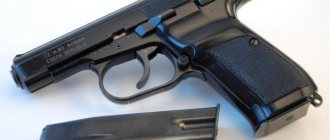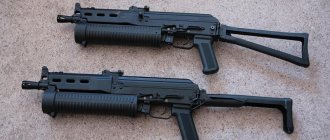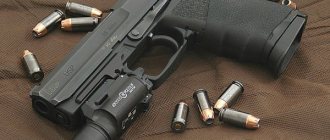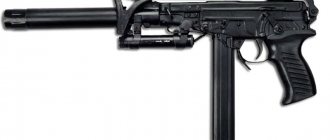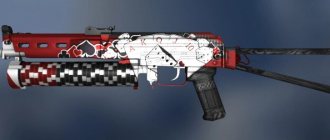Almost until the mid-1920s, the Red Army could boast of a very diverse collection of weapons. As personal weapons, the fighters carried both ancient revolvers from 1885 and foreign typewriters. In the West, almost all armies recognized the undoubted advantage of a self-loading pistol over a revolver - in fact, only the eternal retrograde Englishmen carried revolvers. The Soviet Union began developing its own pistol quite late. But the result of the flight of design thought was the legendary Tulsky-Tokarev automatic pistol, which faithfully served the fatherland for a good fifty years.
Contest
In the fall of 1930, the last stage of the competition to create a self-loading pistol took place. The main participants were the developments of F.V. Tokareva, S.A. Korovin and S.A. Prilutsky, who also had to compete with foreign opponents: the command of the Red Army was considering the possibility of equipping the command staff with already established Western pistols. The first field tests revealed a clear leader. The tactical and technical characteristics of the TT were significantly superior to the famous Walter RR, Parabellum R-08, Browning M1922 and Colt M1911.
Upgrade options
Tuning a Tokarev pistol is less popular than improving the famous Makarov.
Nevertheless, inventive craftsmen are trying to improve its technical characteristics.
Accessories
The handles are equipped with wooden, plastic or rubberized pads, and LED front and rear sights are believed to improve aiming speed.
A muzzle brake-compensator is installed on the barrel, which removes recoil and stabilizes the barrel. This detail decorates the pistol and gives it an aggressive look.
Such chips are ordered abroad or made on a milling machine ourselves. External tuning is difficult to do without a turning and milling machine.
There is no possibility of installing a collimator or under-barrel flashlight. The holes in the trigger give the pistol an entourage and similarity to the Colt 1911. Picatinny rails allow you to attach an under-barrel laser target or a flashlight.
The heel of the magazine allows you to increase the capacity by 1 round. Gold and silver plating is used. LCC, an under-barrel laser pointer that allows you to shoot without aiming at short distances.
To carry a Tokarev pistol, you can buy a belt holster with an open and closed design, for concealed carry, a shoulder holster and a waist holster with a fastening.
Birth of a legend
The development of Fedor Tokarev was very much liked by the chief of armaments of the Red Army, Jerome Uborevich, who wrote an enthusiastic report on the results of military tests. Uborevich petitioned for the start of mass production of the TT automatic pistol - the very next day after the report, on February 13, 1931, a decision was signed to produce a thousand pistols for subsequent transfer to the troops.
The 7.62-mm automatic pistol of the Tokarev system turned out to be the best of the domestic models, not inferior in reliability and ease of handling to foreign pistols - Chief of Arms of the Red Army Ieronim Uborevich
TT-T barrel design
Our review will not do without talking about the barrel of a traumatic weapon, because here it receives special attention. The fact is that, as a rule, when converting a combat pistol into a traumatic one, instead of the original barrel, a tube of the required diameter is installed, that is, the original barrel is completely replaced. The TT-T traumatic pistol was the first of its kind, where the original barrel, designed for the use of combat charges, was left.
Of course, this could not have happened without some changes, otherwise the weapon simply would not have passed the required certification. To do this, a special pin was installed directly in front of the chamber, which covers the barrel bore by a third. The peculiarity here is the close location of the pin to the chamber. Since the bullet does not yet have time to gain speed when fired, there is a small load on the pin, which greatly reduces the possibility of its breakage.
The rifling from the bore was also removed. The designers worked hard on this and did everything so well that re-polishing the barrel bore after purchasing the TT-T will not be necessary. Of course, you can polish it at your own discretion, but this will not affect shooting in any way. We can only note that the TT-T pistol will be easier to clean after use.
Elegant simplicity
One of the main advantages of the TT can be considered the thoughtful simplicity of the design. The pistol was suitable for mass production due to its low cost and was very undemanding in maintenance. Fedor Tokarev perfectly understood how important both of these factors were for an army pistol - even an inexperienced fighter could master the weapon in the shortest possible time.
[edit] Notes
- Not counting the Pieper revolver, from which the Nagan brothers scrapped the idea after the original patent expired.
| [ + ] TT - death in the hands of political instructors and killers | |||||||||||||||||||||||
| |||||||||||||||||||||||
Main characteristics
- Caliber 7.62 mm
- Cartridge 7.62x25 mm
- Weight without cartridges 0.845 kg
- Weight with cartridges 0.940 kg
- Length 195 mm
- Barrel length 116 mm
- Combat rate of fire, 8 shots 10-15 seconds
- Initial bullet speed 420 m/s
- Rate of fire 30 v/m
- Magazine capacity 8 rounds
- Sighting range 50 m
Tokarev TT pistol / 7.62 mm self-loading pistol mod. 1930 (USSR)
Tactical and technical characteristics (TTX) TT arr. 1933
- USM - single action
- Caliber, mm - 7.62×25mm TT
- Length, mm - 195
- Height, mm - 120
- Width, mm - 28
- Barrel length, mm - 116
- Rifling - 4, right-handed
- Rifling pitch, mm - 240
- Weight without cartridges, g - 825
- Weight with cartridges, g - 910
- Magazine capacity, cartridge. - 8
- Rate of fire, v/m — 30
- Initial bullet speed, m/s - 420
- Sighting range, m - 30-50
- Trigger force when firing from combat cocking, N, no more than - 21
The TT pistol (Tula Tokarev, GRAU Index - 56-A-132) is a self-loading pistol developed in 1930 by Soviet designer Fedor Vasilyevich Tokarev.
The TT pistol was developed as a result of tests carried out since the mid-1920s. with the aim of creating a modern semi-automatic weapon, which was supposed to replace the outdated Nagant revolver of the 1895 model and a number of foreign semi-automatic models. One of the most popular foreign models was the then famous Mauser S-96. In the 1920s It was purchased in large quantities, and the Red Army appreciated its powerful 7.63 mm cartridge. It was decided to create our own model for this ammunition.
Several pistols from different designers were tested, and in the end the choice fell on the model of gunsmith Fedor Tokarev. In 1930-32 Several thousand copies were produced, but field tests revealed a number of shortcomings. Tokarev made the necessary changes to the design, and at the beginning of 1934 the pistol was put into service under the name TT-33 (7.62mm Tokarev self-loading pistol of the 1933 model).
Like the previous model, the TT-33 was in many ways reminiscent of the American M1911 Colt self-loading pistol with its use of recoil energy and a lowering breech, but the TT-33 was still not just a copy: for example, the hammer, mainspring and other components were combined into a module that could be removed through the back of the handle. In addition, some other changes were made (for example, locking lugs were made around the entire barrel, and not just on top).
Due to this, the production process and maintenance of the pistol in the field were simplified. In addition, the length of the side walls of the magazine, which now entered the chamber, was increased, thereby reducing the likelihood of a cartridge being delayed in the event of slight deformation of the magazine. The result was a practical and durable weapon, which, like other worthy examples of Soviet weapons, operated reliably even in the most difficult conditions.
It was produced in ever-increasing quantities until the beginning of the Great Patriotic War. By June 22, 1941, about 600 thousand TT-33s entered service with the Red Army. During the war years, production increased even more.
In 1938-39, work was carried out to introduce a more modern pistol into service with the Red Army, but due to the outbreak of the war, it was not completed. In 1942, a TT version with a double-row high-capacity magazine was created, but not mass-produced.
In World War II, the Germans actively used captured weapons, including pistols captured from Soviet arsenals during the initial period of the war. TT-30 and TT-33 were sent to armament of German army units and units, as well as to ground units of the Air Force under the designation “Pistole 615 (R)”. The use of captured pistols was explained by the fact that the Soviet 7.62 mm cartridge mod. 1930 type P was almost identical to the German 7.62 mm Mauser cartridge, which in turn could be used in two types of Soviet pistols.
Pistol TT arr. 1933, with holster By 1945, the TT-33 almost completely replaced the Nagant revolver in service with the combat units of the Red Army. As Soviet influence spread, the distribution and production area of the TT pistol expanded.
In 1946, the TT was slightly modified, which reduced its cost. The external difference between the post-war samples was that they had fine corrugation on the bolt casing instead of the vertical semicircular grooves of the pre-war ones. Pistol production in the USSR continued until approximately 1952, when the 9-mm Makarov pistol (PM) was adopted.
However, the TT continued to be used in the Soviet Army until the 1960s, and in the police until the 1970s. In total, approximately 1,700,000 TT pistols were produced in the USSR.
In addition, in the late 1940s - 1950s, the USSR transferred documentation and licenses for the production of TT to a number of allied countries, namely Hungary, China, Romania, North Korea, and Yugoslavia. In these countries, TT pistols were produced both for the armed forces and for export and commercial sale.
On its basis, various models were created, which were essentially copies. Thus, Poland produced the TT-33 for its own needs and export to the GDR and Czechoslovakia, Yugoslavia produced a pistol for itself and other countries under the designation M65, in China the pistol was produced under the designation “type 51”, and in North Korea it was called M68.
The most thoughtful approach to copying was in Hungary, where they made several changes to the design and remade it for the 9-mm Parabellum cartridge. The result was designated the Model 48, and the export version for the Egyptian police was Tikagipt.
Export versions could have a different caliber 9x19 mm Parabellum, as well as a non-automatic fuse of one design or another. In China and Yugoslavia, TT-based pistols are still produced.
In the 90s, the TT became popular among killers. He is given several basic explanations: the power of the cartridge, which allows the bullet to easily pierce barriers and light body armor, as well as the low cost and ease of acquisition (there were large numbers of TTs stolen from military depots of the countries of the former USSR on the black market of weapons), which made it possible to use the pistol without significant expenses once and discarded at the scene of the crime, thus avoiding the risk of being caught with the weapon and being presented with evidence related to its previous use. In addition, the vast majority of TT pistols did not have fired samples in the bullet case collection of the Ministry of Internal Affairs, which significantly complicated the conduct of operational search activities in the event of crimes being committed.
The TT used a short-stroke recoil barrel. The Browning swing-ear system, derived from the Colt M1911 pistol, was modified to simplify production. The trigger mechanism did not have a manual safety. An unwanted shot was prevented only by a disconnector and a cutout for setting the trigger to the safety cock.
A single-action trigger trigger with an open hammer is designed as a separate, easily removable module to simplify incomplete assembly and disassembly. A few years later, Swiss gunsmith Charles Petter used the same design in the French Model 1935 pistol. The steel magazine contained 8 rounds. The pistol does not have any special safety devices; only pre-cocking is provided. The advantages of the pistol are its simple and reliable design and a powerful high-velocity cartridge, which provides relatively high accuracy and effective firing range, as well as the penetrating effect of the bullet.
The fixed front sights were zeroed at the factory for a shooting distance of 25 meters. Accuracy of shooting from a pistol is ensured by the low location of the bore axis in relation to the handle to reduce the recoil shoulder, reduce the recoil speed due to the use of a massive bolt casing, and also by bringing the center of gravity of the weapon closer to the handle.
The cheeks of the handle are plastic or (during the war years) wooden, with large vertical corrugations. At the bottom of the handle there is a swivel for a pistol belt. The cartridges are fed from detachable single-row box magazines with a capacity of 8 cartridges. The magazine release is a push-button type and is located at the base of the trigger guard on the left.
TT is distinguished by its simplicity of design and, therefore, low production costs and ease of maintenance.
It has high bullet penetration (pierces a steel helmet from 50 m), significant kinetic energy of the bullet (slightly less than 500 J) with a flat trajectory, and effective accuracy sufficient for such a weapon. The TT is a flat pistol, convenient to carry, including concealed. However, during operation, shortcomings also appeared.
A serious drawback is the lack of a full fuse. Because of this, numerous accidents occurred, and even in the “Investigator’s Handbook” there was a chapter in which a typical “crossbow” TT was considered from a blow (in order to distinguish a truly accidental incident from one staged by a criminal). Unfortunately, after this mass of accidents due to the fall of a loaded pistol, the Ministry of Internal Affairs ordered it forbidden to carry a pistol with a cartridge in the chamber.
Another drawback is poor magazine retention, which in combat conditions often led to the shooter being disarmed. The ergonomics of the TT raises many complaints compared to more modern designs. The angle of inclination of the handle is small, the cheeks of the handle are thick and rough.
Some authors believe that a bullet fired from a TT pistol does not have sufficient stopping power due to its high speed and relatively small diameter. Others believe that the term “stopping effect” itself has no meaning, and the severity of the wounds inflicted by the TT is quite sufficient to defeat the enemy.
However, when shooting indoors, one should be aware of the possible ricochet, and in urban conditions, the high flatness of the ammunition, which can create unnecessary problems if the rule “before shooting, clearly see the situation in front of and behind the target” is violated. The shortcomings of the standard TT cartridge can be partially compensated for by cartridges with expansive (that is, opening like a flower when hitting the target) bullets. But such cartridges are prohibited for military use, and in some countries for self-defense.
Due to these negative factors, the TT is unsuitable as a modern self-defense weapon and police weapon.
Design of parts and mechanisms of the TT pistol:
Trunk
The inside of the barrel has a chamber and a rifled bore with four rifling winding from left to right.
On the outside there is a thickened part with annular grooves, a boss with a slot and a hole for the earring, as well as a cutout in the rear for the ejector tooth and a bevel to facilitate feeding the cartridge from the magazine into the chamber.
Shutter housing
The shutter is integral with the casing.
On the outside, the bolt casing has a transverse groove for the front sight rear sight, a groove for the ejector with a socket for its spring, a hole for the ejector pin, grooves for the convenience of manually retracting the bolt casing to the rear position, a hole for the firing pin, a cutout for the bolt stop tooth, and a tube for return spring.
Inside the bolt casing there are two protrusions for the guide coupling, two protrusions for connecting to the barrel, longitudinal grooves for guiding the bolt casing, a protrusion for the trigger spring stop, a cutout for the passage of the sear and a through groove for the trigger.
Barrel: 1 - thickened part; 2 — ring grooves; 3 - tide; 4 - cutout (top)
Shutter housing: 1 - rear sight; 2 - window; 3 - front sight; 4 — groove for ejector; 5 - tube
Frame
It is integral with the pistol handle and the trigger guard and has a groove for placing the return spring and moving the bolt housing tube, grooves for the barrel lug and earring, a ledge for stopping the guide rod of the return spring, holes for the bolt stop axis, a stand for the bolt stop spring, protrusions for guiding the bolt casing, cutouts for the ledges of the trigger block, a hole for the bolt stop tooth, a window with a bevel to ensure the supply of a cartridge from the magazine and placement of the trigger block, the trigger and the top of the magazine.
The handle has side windows to make the pistol lighter, a window for inserting a magazine, a socket for hooking a magazine, recesses for securing the cheeks and a slot for triggering.
Frame: 1 - side windows; 2 - cutout; 3 - protrusion
Trigger mechanism
Its peculiarity is that some of the parts are placed in a separate block.
The trigger consists of a firing pin with a spring, a sear, a disconnector, a trigger, a mainspring, a trigger block, a trigger with a rod and a trigger spring.
The trigger, mainspring, sear and disconnector are placed directly in the trigger block.
The firing pin with the spring is placed in the bolt channel and has a firing pin and a recess for the passage of the pin.
The USM block serves to combine part of the USM parts into an independent unit, facilitating its assembly and disassembly.
The block has feathers with bevels to direct the movement of the cartridge from the magazine to the chamber and protrusions for connection with the pistol frame; three holes for the hammer axes, sear and mainspring pins; channel for disconnector; groove for the sear spring.
USM block: 1 - protrusion; 2 — hole for the mainspring pin; 3 — hole for the sear axis; 4 — hole for the trigger axis; 5 - feather (top)
Trigger: 1 - safety protrusion; 2 — combat ledge; 3 - arc groove; 4 - head
The trigger has a head with a notch for cocking, a safety protrusion, a combat protrusion, a path for the passage of the disconnector blade, a hole for the axle, an arc groove for the passage of the mainspring pin, and a socket for the mainspring.
The mainspring is twisted and located inside the trigger.
The sear has a groove for placing the sear spring, a ledge for stopping the trigger rod, a spring, a hole for the axle, and a protrusion for locking the disconnector when setting the trigger to the safety cock.
The sear spring is a plate spring, pressed at one end into the sear groove.
Sear: 1 — hole for the axle; 2 - groove; 3 - spring; 4 - protrusion; 5 - ledge
The disconnector ensures automatic self-cocking of the pistol and consists of a stem with horizontal inclined edges on top, with which it rests against the recess of the bolt; blades with an oval hole for the sear axis; cranked protrusion for engagement with the protrusion of the sear and for lowering the trigger rod.
Disconnector: 1 — blade; 2 - stem; 3 - cranked protrusion
The trigger is integral with the trigger rod, which has a protrusion for resting the trigger spring and a cutout for the passage of the sear.
Trigger rod and trigger spring
The trigger spring is plate-shaped, with a bend on one side to rest against the rear wall of the trigger rod and a bend on the other end for the pin.
Locking mechanism
The operation of the locking mechanism is ensured by the following parts: an earring, annular protrusions on the upper inner surface of the bolt casing, annular recesses on the thickened outer surface of the barrel, and a return spring.
The earring has two holes: one for the earring axis, the second for the bolt stop axis. The lower part of the earring is widened to limit its backward movement.
Earring (left)
Bolt stop and its spring
Return mechanism
The return mechanism consists of the following parts: return spring, return spring tip, return spring guide rod and guide bushing.
The return spring is twisted, cylindrical.
The tip of the return spring has an annular groove at the rear end (slightly larger in diameter) for entering the first turn of the spring; a whisk for resting on the guide bushing; head at the front end, the tip of which fits into the guide sleeve.
The guide rod of the return spring has a head, which rests against the front ledge of the frame.
The guide bushing has a flange for closing the front part of the bolt casing, an annular groove and flat sides for connection with the bolt casing and a hole for the tip of the return spring.
Mechanism for removing spent cartridges
This mechanism consists of parts: an ejector with a spring and a cartridge reflector.
The ejector has a tooth that slides over the edge of the sleeve, a hole for a pin, and an elongated arm for the spring stop.
The elongated left feather of the trigger block acts as a reflector of the cartridges here.
Return spring, tip, guide rod and bushing (top)
Ejector and its spring
Safety devices
Protection against an accidental shot is carried out by setting the trigger to the safety cock.
Sights
The sight is a permanent, open type, consisting of a front sight, which is made integral with the bolt casing, located in its front upper part, and a rear sight, inserted with its base into a groove on the bolt casing.
Cartridge feeding mechanism
It consists of a bolt casing, a magazine and a magazine latch.
The magazine consists of a box, a feeder spring, a feeder, a magazine cover, and a cover delay.
Feeder (top)
Magazine cover (middle)
Magazine box (left)
Feeder spring (right)
The magazine latch consists of three parts: the magazine latch base, the split pin and the spring. The latch has a tooth for gripping the magazine and a channel with a ledge for a split pin.
The cheeks of the handle provide cover for the windows of the handle and have grooves on the outer surface, recesses for the trigger pull, a protrusion and recess for fastening the cheek strips, a notch and a cut on the left cheek for the handle eyelet for the belt.
Operation of parts and mechanisms
Initial position
The casing-shutter takes the forward position under the action of the return spring.
The return spring is at its lowest preload.
The earring occupies a vertical position and holds the breech of the barrel in the upper position.
The barrel, with its recesses, is connected to the protrusions of the bolt casing. The barrel is locked.
The trigger, under the action of the mainspring, takes the upper position and presses on the firing pin.
The firing pin, under the action of the trigger, comes out behind the mirror of the shutter cup and compresses its spring.
The sear, under the action of its spring, is pressed with its nose to the lower surface of the trigger.
The disconnector, under the action of the rear protrusion of the trigger rod, occupies the upper position, and its head is located in the recess of the bolt.
The trigger is in the forward position under the action of the trigger spring, and the rear end of the trigger rod is raised and engages with the sear.
The bolt stop, under the action of its spring, lowered the tooth down.
The position of the parts of an unloaded pistol: 1 - housing-bolt; 2 - trunk; 3 - earring; 4 - drummer; 5 — trigger block; 6 - trigger; 7 — mainspring; 8 - sear; 9 — trigger rod; 10 — trigger spring; 11 — cheeks of the handle; 12 - store; 13 — magazine latch; 14 — frame; 15 — return spring; 16 — guide sleeve
Loading
In order to load the gun, you must perform the following operations:
- equip the magazine with cartridges;
- insert the magazine into the pistol grip;
- pull the shutter housing back all the way and release sharply;
- put the trigger on safety cock.
After inserting the magazine into the pistol grip, the magazine latch tooth slides into the box cutout and holds the magazine in the grip.
The upper cartridge rests against the lower wall of the bolt rammer and goes down slightly, moves all the cartridges down and additionally compresses the feeder spring.
When the bolt casing moves back, it moves the trigger to the rear position, pulls the barrel along the annular grooves and compresses the return spring.
The barrel, moving back, turns the earring.
The earring, rotating around the bolt stop rod, pulls the breech of the barrel down, forcing it to lower.
When the breech is lowered, the barrel is disengaged by annular grooves from the annular protrusions of the bolt casing, rests against the bottom of the frame groove and stops.
The barrel bore is unlocked, and then the bolt casing moves alone until the rear edge of the tube rests against the head of the return spring guide rod.
The firing pin moves back under the action of its spring, and its firing pin is hidden behind the bolt cup.
The disconnector, under the influence of the bevel of the recess on the lower part of the bolt, moves down, with its cranked protrusion deflects the trigger rod downward and disengages it from the sear ledge.
The trigger, under the action of the bevel of the rear part of the bolt, moves back, compresses the mainspring and is cocked.
The sear, under the action of its spring, slides with its pressed nose along the lower part of the trigger, jumps over the safety cocking, jumps over the cocking protrusion and keeps the hammer cocked.
After the bolt passes the rear wall of the magazine, the upper cartridge, under the action of the feeder spring, rises up until it stops at the edges of the walls of the magazine and stands in the path of movement of the bolt.
When moving forward under the action of the return spring, the bolt removes the cartridge from the magazine, sends it into the chamber, hits the breech of the barrel and moves it forward.
The ejector sticks its tooth into the annular groove of the cartridge.
The barrel, moving forward, turns the earring.
The earring, turning, lifts the breech of the barrel upward.
The annular protrusions of the bolt casing fit into the annular recesses of the barrel and lock the barrel bore.
The trigger rod, under the action of the trigger spring, rises with its rear end upward, lifts the disconnector and engages with the sear.
The disconnector, rising, enters its head into the recess of the bolt.
The pistol is loaded, the hammer is cocked.
Operation of pistol parts when loading
Setting the safety platoon
If there is no need to shoot, then the pistol is put on safety cock. To do this, you need to place the thumb of your right hand on the trigger head, press the trigger with your index finger, and smoothly release the trigger until the safety cock is set.
When the trigger is pressed, the trigger rod presses the back wall onto the sear ledge and turns it.
The sear, turning, removes the nose from under the cocking trigger.
The trigger, under the action of a spring, begins to rotate on an axis; its movement is delayed by a finger.
The trigger rod, after the release of pressure on the trigger under the action of the trigger spring, moves forward and moves the rear wall away from the sear ledge.
The sear, under the action of its spring, is pressed with its nose to the lower part of the trigger, slides along it until it meets the safety cocking of the trigger, passes the lower protrusion behind the cranked protrusion of the disconnector and does not allow it to fall.
The shutter is locked.
The position of the pistol parts when the trigger is cocked
Shot
To fire a shot, you must cock the trigger and pull the trigger.
To cock the trigger, turn the trigger with the thumb of your right hand.
The trigger, rotating on an axis, compresses the mainspring.
The sear, under the action of its spring, is pressed with its nose to the lower part of the trigger, slides along it, jumps behind the cocking cock and keeps the hammer cocked.
Pulling the trigger moves it back.
The trigger rod with its rear wall will press on the ledge of the sear and bring the nose of the sear out of the cocking protrusion.
The trigger, under the action of the mainspring, turns sharply on its axis and hits the firing pin.
The firing pin, compressing its spring, transfers the striker strike to the cartridge primer and ignites it. Shot.
The bolt, together with the barrel coupled to it, moves back under the action of recoil.
The parts work in the same way as with a manual release of the bolt casing, with some exceptions. The ejector removes the spent cartridge case from the chamber and holds it until the case head hits the reflective protrusion of the left blade of the trigger block, under the action of which the cartridge case flies out of the bolt window to the right forward upward.
At this moment, the next cartridge in the magazine rises upward under the action of the feeder spring.
If the magazine runs out of cartridges, the feeder hook lifts the bolt stop by the tooth, its outer protrusion slides into the cutout of the left wall of the bolt casing and stops it in the retracted position.
If there are cartridges in the magazine, the bolt returns to the forward position under the action of the return spring.
From this moment on, the operation of the pistol parts is the same as when manually chambering a cartridge.
The trigger, after ceasing the pressure on it, returns to the forward position under the action of the trigger spring. The rear wall of the trigger rod raises the disconnector, the stem of which fits into the recess of the bolt.
The position of the pistol parts when fired
The position of the trigger parts when the trigger is cocked (left) and released
The operation of the pistol parts when fired (a-d) and the position of the pistol parts after the shot (e)
After all the cartridges have been used up, the bolt locks onto the slide stop.
Soviet post-war TTs
To this day, the post-war TT pistol is in service with military personnel units and irregular formations in some CIS countries.
The service life of these pistols, produced in the forties and fifties, has long been exhausted, so they are extremely unreliable. Common defect? misalignment of the cartridge and its sticking.
Previously, standard army pistols were used for sports shooting, since, according to the conditions of the competition, design changes and modifications were not allowed. On the basis of the TT pistol, designer Sevryugin created two models of sports pistols in the fifties: R-3 and R-4. The R-3 pistol had a blowback action and fired 5.6 mm cartridges.
Video about the TT pistol:
For the P-4 model, an attached holster was developed - a buttstock, which was attached to the back of the handle. In most cases, the shooters “refined” the trigger force allowed by the competition rules, equal to one and a half kilograms.
The use of a stock when firing from the R-4 allows for fairly high fire efficiency at distances significantly exceeding the usual 25-50 meters provided for personal weapons.
TT has become widespread in foreign countries. In the early nineties, this pistol returned home again: thousands of TTs, mostly made in China, poured into the Russian arms market like an avalanche.
Table of excess (decrease) of the average trajectory when shooting from a pistol, normalized for normal combat at 25 m.
| Distance, m | Excess (decrease), cm | Radius of a circle centered at the containing STP | ||
| With an excess of the average point of impact (STP) 12.5 cm above the aiming point | With combination of STP with the aiming point | 100% holes (R100), cm | 50% holes (R50), cm | |
| 10 | +5,4 | +0,4 | 3,5 | 2,0 |
| 15 | +8,0 | +0,5 | 5,0 | 3,0 |
| 20 | +10,4 | +0,3 | 6,5 | 4,0 |
| 25 | +12,5 | 0 | 7,5 | 4,5 |
| 30 | +14,7 | — 0,3 | 9,0 | 6,0 |
| 40 | +18,7 | — 1,3 | 12,0 | 7,0 |
| 50 | +21,8 | — 3,2 | 16,0 | 8,0 |
Notes on the table.
The “+” sign indicates an excess of the trajectory above the aiming point, and the “-” sign indicates a decrease.
Traumatic version
Based on the pistol, there are its traumatic variants called TT-Leader and MP-81, supplied to the civilian market as self-defense weapons.
Disassembly and assembly of the TT pistol
Self-loading pistols are products of fine mechanics and technology. To ensure reliable operation, you need to know their structure and be able to recognize the first signs of an impending technical illness. An important and mandatory step in this direction is to master the skills of disassembling and assembling weapons. Disassembly of the pistol is divided into incomplete (partial) and complete.
Partial disassembly is carried out for the purpose of maintenance of the gun, its inspection and lubrication. Complete disassembly is required much less frequently, but it is mandatory in cases where the pistol has been in special conditions - it fell into water, fell into the mud, or was in various environments of increased aggressiveness for a long time.
The first necessary rule for performing this operation is to choose a clean and comfortable place. A smooth table, a wide bench, and even bedding are best suited for this. During complete disassembly, it is necessary to maintain accuracy and order: place parts and mechanisms in the order of disassembly, handle them carefully, and avoid sharp impacts. When assembling, pay attention to the numbering of parts - confusion with parts of other pistols, even of the same system, is unacceptable.
Partial disassembly of the TT pistol
- By pressing the magazine release button, remove the magazine from the pistol handle (Fig. 1).
- Remove the pistol from the safety cock by cocking the hammer (Fig. 2), pull the bolt back and check if there is a cartridge in the chamber (Fig. 3).
- Release the shutter and smoothly pull the trigger.
- Remove the bolt stop: to do this, use the end of the magazine cover to move the bolt stop spring back and push it back by the protrusion so that it releases the bolt stop axis (Fig. 4) (do not remove the spring, but leave it on the stand), then, pressing protruding part of the bolt stop axis, remove it from the frame (Fig. 5).
- Remove the bolt with the barrel, to do this, hold the return spring and move the bolt forward along the grooves of the frame.
- Remove the return spring along with the guide rod and tip from the valve (Fig. 6).
- Turn the guide sleeve 180° and pull it forward from the bolt (Fig. 7).
- Turn the bolt so that the supporting protrusions of the bolt come out of the annular grooves of the barrel and the barrel moves slightly forward; tilt the earring forward and remove the barrel (Fig. 8).
- Remove the firing mechanism block (Fig. 9).
The practice of operating the pistol has made its own adjustments to the procedure for disassembling and assembling the pistol.
Thus, to avoid deformation of the return spring during disassembly, before separating the bolt stop, the guide sleeve is usually separated, for which the tip of the return mechanism is recessed with a ramrod (Fig. 10), the guide sleeve is rotated 180° and removed from the barrel (Fig. 7), and the held by hand, the return mechanism is slowly unloaded (Fig. 11).
After this, the release of the bolt stop occurs without the slightest effort.
Partial disassembly of the pistol is completed.
The pistol is reassembled in the reverse order.
To connect the barrel to the bolt, the barrel must be inserted into the bolt, tilting the earring back. When installing the bolt on the frame, the trigger block should be recessed so that it does not interfere with the free movement of the bolt. To attach the bolt stop, move the bolt back a little so that the hole in the barrel mount aligns with the hole in the frame.
Complete disassembly of the TT pistol
Before complete disassembly, it is necessary to partially disassemble the gun. Further disassembly is carried out as follows:
USM block assembly
Disassemble the trigger block:
- Pull the trigger back, knock out the sear axis and remove the sear and disconnector.
- Using the disconnector rod, push out the trigger axis and separate it along with the spring. It is necessary to hold the spring and ensure that it does not fly out when the load is released.
Disassemble the frame:
- Using the long feather of the trigger block, turn the tail of the fastening bar of the left cheek and, pressing on it from the inside, separate it. Repeat the same with the right cheek.
- Press the lid catch upward and, pressing from the inside, separate the release spring and latch from the lid.
- By pressing the split head of the magazine latch pin, push it out of the base and frame. Separate the base from the frame and remove the magazine latch spring from the pin.
- Remove the trigger from the frame socket, moving it forward.
Disassemble the return spring:
- Separate the guide rod from the return spring.
- Separate the tip from the return spring by turning it in different directions.
A bolt with sights, a hammer with a spring and a split axis
Disassemble the shutter:
- Knock out the striker pin and remove the striker with the spring.
- Repeat the same operation with the ejector.
Disassemble the store:
- Press the pointed end of a match or pin into the magazine cover catch, slide it forward and, holding the spring catch, remove the cover.
- Remove the spring with the feeder.
Complete disassembly of the pistol is completed.
Details of partial disassembly of the TT pistol
Reassemble the pistol after complete disassembly in the reverse order. When assembling the magazine, after inserting the feed spring, a delay is applied to it with the bent end outward and forward.
By pressing it, the delay should be recessed flush with the bottom edge of the magazine and, holding it in this position, slide the lid onto the magazine. After assembly, it is necessary to check the functionality of the gun.
When operating a TT pistol you need to know:
- operation of a new pistol must begin with careful removal of the conservation lubricant, disassembling all detachable connections of the pistol parts and especially removing it from the firing pin channel, otherwise at subzero temperatures this will lead to misfires,
- the pistol's lifespan exceeds 6,000 shots at the most intense firing mode (96 shots in a row - 12 loaded magazines, and subsequent cooling in water or air to ambient temperature);
- the bores of TT pistols are not chrome-plated, so special attention should be paid to cleaning them to avoid corrosion;
- It is prohibited to perform idle trigger releases without a training cartridge or a spent cartridge case in the chamber in order to avoid breaking the split axis of the firing pin; release the hammer from the cocking position smoothly, while holding it.
Photo of the TT pistol:
Undoubted advantages
The TT was designed for a very powerful cartridge, atypical for pistols, capable of providing high penetrating power and muzzle energy of 500 J. The light and short trigger significantly increases shooting accuracy: experienced craftsmen hit targets at 50 meters. In addition, the pistol is quite compact and flat - convenient characteristics for a concealed carry weapon.
Serious disadvantages
Naturally, the pistol had its drawbacks, and quite significant ones. The magazine was not secured very securely - the shooter could find himself without ammunition at the most crucial moment. The number of crossbows was so large that the soldiers had to be prohibited by the Charter from carrying a pistol with a cartridge in the chamber. As a result, the time it took to bring weapons into combat readiness when meeting an enemy increased. The handle also causes some confusion: the small angle of inclination and the specific shape made the pistol quite uncomfortable.
Conversion options and modifications
Based on the TT pistol, many modifications of the pistol were created by Soviet and foreign designers for various purposes.
Based on the drawings transferred by the USSR to Hungary, a modified scheme was developed: the weapon was intended for 9 mm cartridges.
In China, according to Soviet drawings, the TT pistol was produced, first with the index “type-51”, later - “type-54”.
Sports weapons
At the very end of the Second World War, the process of conversion of military production began. The designers were tasked with developing a small-caliber sports pistol.
- First the R-3 was developed, then the R-4 for the small-caliber 5.6 mm cartridge.
- The S-TT sports pistol was produced in the 30s–50s; it is no different from the combat prototype.
Traumatic weapon
Trauma is a weapon for self-defense.
- TT-Leader. Its prototype is the TT-33. The version retains the design and construction of the trigger. Accuracy leaves much to be desired. Instead of a barrel there is a simulator (there is no barrel), as a result the spread of bullets is too large even for a traumatic weapon. Out of production. TT-T is another version based on military weapons.
- MP-81 - based on the TT: the frame, bolt, and trigger were copied (combat pistols were remade). Used with rubber bullets and traumatic cartridges, gas and noise cartridges.
Pneumatic versions
The pistols listed below are 4.5mm caliber:
- Gletcher TT. It has a plastic body, so it is quite lightweight - up to 400 g. The shutter is stationary. It is reputed to be a reliable model and is easy to maintain. Good aiming.
- Gletcher TT NBB is a gas-cylinder smoothbore multi-charger. The design is similar to the self-loading TT.
- TTP "Sobr" - gas-cylinder pneumatics produced in Ukraine. The pistol has been discontinued.
- Crosman C-TT is a multi-shot model.
Signal versions
The TT-S signal pistol is a modification of the VPO-501 “Leader”, based on the Tokarev pistol. Production has been discontinued, since modern law prohibits the alteration of military weapons.
Collectibles
Among the collectible weapons there are combat weapons with marks and training ones. It is legally possible to purchase copies that cannot be fired with live ammunition.
By May 9, 2022, the famous jewelry brand released collectible TT pistols - modified versions decorated with gold.
It is worth adding about the Tokarev pistol that the TT is officially considered a premium pistol along with the Makarov pistol, Nagan system revolver, etc.
Combat use
Industrial production for the spacecraft continued until 1951, it was replaced by the Makarov pistol.
But during the war, not only officers were armed with it, but they were also sent to partisan detachments.
Small oddities
- Insufficient fixation of the magazine led to the fact that during the battle the shooter could be disarmed (the magazine fell out of the shaft).
- The handle is directed to the barrel at a right angle, so after throwing the barrel is directed slightly below the target. To hit the target accurately you will have to adapt.
Unpleasant feature
The design of the pistol had one more unpleasant feature, which is worth mentioning separately. Tulsky-Tokarev was deprived of a separate fuse. Its functions should be performed by a deep cutout on the trigger, which locks the bolt and trigger with the sear and disconnector. The combat operations showed that such a solution looked good on the drawings: the real design held up poorly and almost did not ensure the safety of the shooter.
Disassembling the pistol
Disassembly of the pistol may be incomplete or complete. The first option is most often used. Disassembly may be necessary to clean, lubricate, or repair the weapon. To carry it out, you need to prepare a clean place. The parts are laid out in the order they were removed. It is not recommended to stack them on top of each other to avoid the risk of accidental damage. In case of incomplete disassembly, operations are performed in the following sequence:
- You need to remove the magazine.
- Check that the chamber is empty.
- Press the bushing to remove its engagement with the tip of the return spring.
- Turn the sleeve, then take it out along with the spring and tip.
- Slide the bolt stop spring, releasing the rod. Then they take her out.
- Using a forward movement, remove the bolt and barrel.
- The barrel is separated from the bolt by removing it from the muzzle area.
- The trigger mechanism is removed from the frame.
This completes the partial disassembly. Reassembly is done in reverse order.
Well done Bullet
But all the above-described shortcomings are more than offset by the main trump card of Fedor Tokarev’s design. A pointed 7.62 mm bullet fired from a TT is capable of piercing an army helmet and light body armor. A class I body armor will not save the enemy from a “7.62 P” bullet with a lead core, but the “Pst” product with a steel core passes through class II body armor like a knife through butter.
Way of the Warrior
The Tulsky-Tokarev automatic pistol went into mass production in 1933 and remained the service weapon of the Armed Forces of the Soviet Union for 27 years. Law enforcement agencies used the TT until the beginning of 1971; residents of evil residential areas still use it. In the Soviet Union, only before 1952, 1 million 740 thousand pistols of this model were produced: just imagine how many automatic weapons flowed from army warehouses to the streets in the 90s.
History of creation
The history of the creation of the famous weapon, the TT pistol, is associated with the name of the Russian designer Fedor Vasilyevich Tokarev. He was born into a Cossack family. Later he entered a military vocational school in Novocherkassk, where he studied at the weapons department. Later, at the shooting school for training officers in Oranienbaum, he saw one of the first automatic weapons - a rifle designed by Fedorov.
He was interested in the device, despite the imperfections and shortcomings, the first automation carried a new idea that had advantages. The Russian army did not have such weapons.
In 1908, Fedor Vasilyevich developed an automatic rifle; the designer took the Mosin three-ruler as a basis. The work was supported by the Artillery Committee. But the weapon required improvements, and in 1910 Tokarev presented a new model and a rifle of his own innovative design. The idea was to convert the Mosin three-line rifle into an automatic one.
This rifle fired a single shot, then manually reloaded, as a result of which the sight was already knocked off the line of fire, although the magazine held 5 rounds. Thus began work on the creation of a Russian automatic rifle.
In the post-revolutionary period, Fyodor Vasilyevich was sent to Tula, where he worked as chief engineer at the Tula Arms Factory. There he designed the MT light machine gun. The Tula TT pistol was created by Tokarev for a competition, the purpose of which was to select successful weapons for arming the army. Why is the weapon called TT: the abbreviation is associated with the name of the inventor Tokarev, who invented it, and the Tula plant.
It was declared the most acceptable, but the commission demanded that the design of the TT pistol be modified in terms of safety and accuracy.
A few months later, the designer presented an improved version, it met expectations and was accepted into service. A cartridge with a bottle sleeve and a jacketed bullet for the TT pistol was adopted for service in 1930. Among the soldiers, the pistol was nicknamed “TT” - Tula Tokarev.
But for several years the design was modernized. I had to revise the drawing of the clip, because the cartridges from the TT pistol were distorted, and the bolt quickly wore out. And the pistol could not be used when firing from a tank through a rifle embrasure. The reliability of the pistol also left much to be desired, as did the service life of 200–300 shots; there were frequent breakdowns and malfunctions, which meant that modernization was again required.
The pistol was modified primarily to reduce the cost and simplify the technological process. After modernization in 1933, the plant became able to produce the modernized TT pistol in the required quantity. By the beginning of the war, over 100 thousand pieces were produced.
During the Second World War, the TT became the main personal weapon of the officers and generals of the spacecraft. It was used in close combat with a distance of up to 50 m.
In 1951, production of the TT was stopped and it was replaced by the Makarov pistol, the famous PM. How does the Makarov PM pistol differ from the TT: first of all, its purpose is not for use in military conditions, but for the police in peaceful conditions. Therefore, the inventor made it lighter and more compact. Automatic free shutter.
It is believed that PM is safer, more comfortable to wear and easier to operate. In the same 1951, the Stechkin APS automatic pistol began to be produced.
